
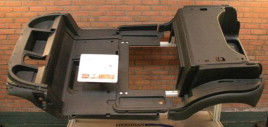
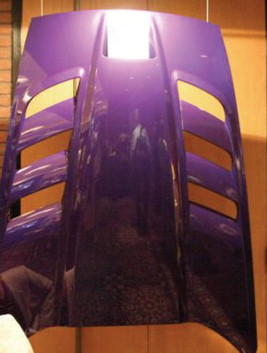
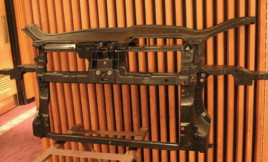
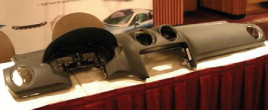
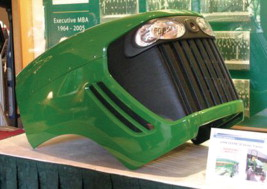
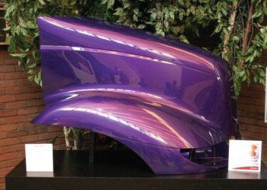
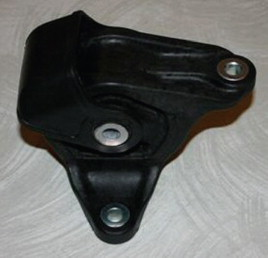
SPE's ACCE 2008 event encompassed eight keynotes and one panel discussion focused on answering the question, “What are the present and future prospects of composites, especially carbon fibre composites?”, leaving other fillers and fibres to be discussed in plenary sessions.
Dr Joseph Carpenter, US Department of Energy (DOE), set the stage addressing the growing demand for oil. Dr Carpenter indicated that despite the fuel cost increases the auto industry is not beating the path toward composites to reduce weight. He indicated there were three challenges: growing demand for oil, urban pollution, and global climate change. By 2050, there will be 3.5 billion vehicles on roads worldwide, an increase of over 300%. We will exceed oil demand for conventional oil supply which he estimated at 1 trillion barrels in the ground. But he pointed out that there are 2 trillion barrels available from tar sands and much more available from methane hydrates in the oceans. He estimates that there is enough unconventional supply for 10 billion people for 5000 years. The problem is that the USA uses more oil than it makes, most of it being used in trucks and cars, with 96% of the land vehicles using oil. Most of the US' oil comes from Mexico and Canada, both of whom are stable trading partners.
He then went into government programmes indicating the Corporate Average Fuel Economy (CAFÉ) standards from 1975 to 1986 progressively increased fuel economy, but from 1986 to the present all the technology was used to increase the weight, customer options, and conveniences, or increase the power output of the vehicles as 0-60 mph times steadily decreased. He maintained that the real price for gasoline has steadily decreased and the lowest real price occurred in 1999.
Fuel economy alone will not drive weight reduction. Presently aluminium, magnesium, steel and composites continue to compete for parts material selection, with steel continuing to have the advantage of being the incumbent with a strong unified trade association lobbying for its use.
New CAFÉ and carbon dioxide (CO2) standards might tip the scales in favour of composite use, particularly if carbon fibre can be reduced in price to the point where it is competitive for the high volume automotive production numbers. This led into the topic of the next speaker, C. David Warren, of Oak Ridge National Laboratories. He told the assembly that for every 10% mass reduction there is a 6-7% increase in fuel economy, indicating the target for carbon fibre is US$5-7/lb. But this is difficult with the present acrylic fibre precursor for making carbon fibre.
Currently, production of carbon fibre involves the heating and oxidation of a polyacrylonitrile (PAN) fibre under tension which yields a long chain carbon fibre. Carbon fibres are divided into strands and then rolled and packaged for delivery. PAN is an expensive precursor and since 50% of it is burned off during carbon fibre formation, costs are increased by a factor of 2. Oak Ridge is testing different precursors, such as textile-grade PAN (similar to that used for making rugs), lignin (a by-product of hardwood or softwood processes), or even polyolefins. Another possibility is not splitting the carbon fibre into individual fibres but rather leaving it as a sheet and processing it directly. Some of these processes may be unsuitable for so called aeronautic-grade carbon fibre but may be highly suitable in automotive uses.
There is increased demand for carbon fibre, with wind energy uses growing fastest, but it is also needed for aeronautics, cranes for oil drilling, hydrogen storage tanks, bridge repair, and military vehicles. There are many consortia looking for ways to increase capacity and lower prices, for example: the National Labs working with the Freedom Car Consortium in the US, and the Japanese trying to vertically integrate into Tier 1 suppliers. Iceland is looking into using its large geothermal energy supply to make carbon fibre, as are the EU, China, UAE, Saudi Arabia, Qatar, and Russia.
Extreme sports
Attendees were treated to a set of presentations on extreme sports using carbon fibre.
Gary Savage outlined the history of Formula 1 racing. In the early days, the cars consisted of tubular aluminium frames with hammered aluminium skin. Early on, composites had been tried and proved problematic with some rather spectacular failures. However in 1992 structural carbon fibre was used for the first time in the McLaren MP4/1. This vehicle proved to be so successful that all doubts were pushed aside and in a short while all Formula 1 race cars contained large quantities of carbon fibre composites. Serious injuries were reduced by a factor of 30 times and repairs which used to be impossible could now be done in time to meet the next day's race schedule.
The second composite race story involved The America's Cup. Jan-Anders Manson, École Polytechnique, showed slides of designing, making, and racing these sailboats.
Trek bikes were next. James Colgrove passed around (incredibly lightweight) carbon fibre bike frame pieces. Before 1992 there was 100 years of steel experience. He quoted the common saying, ‘steel is the feel.’ In the early 1990s, aluminium, magnesium and composite were all brought into evaluation as possible replacements for steel. It quickly became clear that carbon fibre was stiffer, stronger and lighter than its competitor materials. And even with the present three-year lifecycle, carbon fibre is the material of choice for the vast majority of parts for high-end bikes.
All three of these examples indicate initial resistance to carbon fibre composites and then a quick conversion to the technology. All of these technologies also depend heavily on modelling, because development time frames are greatly reduced and failure of even one component can mean years of wasted work.
All of these presentations left one with the feeling that carbon fibre price and supply at the present time is holding back its acceptance and that once price and supply problems are solved, the growth of carbon composites will zoom. In the meantime, according to Crieg Bowland, PPG Industries, long glass thermoplastics have grown at a rate of 13-17% per year and any normal industry would be overjoyed by this growth. Most of the papers dealt with these products as they are evolving into viable and superior automotive parts for the mass market.
Glass reinforced polypropylene
Uday Vaidya, University of Alabama, suggested using continuous unidirectional tape instead of ribs. Testing showed it held up extremely well, with the thicker tapes showing increased stiffness and thinner tapes having more uniform failure. The part made with the unidirectional tape was more damage tolerant.
Mike Birrell, Azdel, presented a method to produce a moulded thermoplastic that combines the versatility of random reinforcement with the thermal stability, strength, and paintability of continuous unidirectional glass fibre reinforced thermoplastic. Azdel uses a random fibre core surrounded by continuous fibre exterior. A hood (bonnet) design exhibited weight savings of 50% over steel combined with good sound deadening and increased damage tolerance.
Paul Stassen, Addcomp, and Frank Henning, Fraunhofer Institute of Chemical Technology (ICT), concluded that their ultra-pure coupling agent allowed 30-50% less coupling agent to be used. When used with wood flour it could double the tensile strength and triple the modulus.
Matthew Marks of SABIC outlined the increased use of glass fibre reinforced polypropylene (PP) for door modules/instrument panel (IP) retainers, and John Shin of Azdel evaluated PP bumpers for energy absorption.
Frank Henning, Fraunhofer ICT, pointed out that countries with high wages need new approaches. One is to make composite materials that can be painted, coated and assembled in the same way as the metal parts they replace. A demanding application is e-coating of the body-in-white (BIW) vehicle. The acid wash and high temperature bakes used during e-coating and final paint of an automotive body is a challenge for many plastics.
Henning found that glass fibre reinforced polyamides (PA) were suitable for BIW applications.
Other polymers
Harsh Bhagat, Ticona, suggested that using linear polyphenylene sulphide (PPS) created 46% lighter weight aircraft seats in the Airbus A380. Demanding automotive applications, requiring high temperature corrosion resistance, light weight and excellent fatigue properties are possible uses.
Edward Kung, SABIC, discussed moulded-in-colour (MIC) plastic parts for vehicle interior components. By combining the properties of polycarbonate (PC) (dimensional stability and ductility) with those of polyester resins (flow, chemical resistance, and wear resistance) in a phase-separated PC/PBT blend and adding inorganic micro-fillers (increasing low temperature ductility and modifying surface gloss), the result makes for an excellent car, truck or industrial use.
Ab van Geenen, Brüggemann Chemical, provided an overview of existing and future applications for reaction injection moulding (RIM) and anionic polyamide 6 (PA 6) in composite products. By using anionic polymerisation of caprolactam it is possible to have both polymerisation and compounding accomplished in one step, resulting in cost savings and a possibility of fast changeover in the forming equipment. He suggests that by using this method it could be possible to make wind turbine blades using thermoplastics instead of thermosets, thus greatly increasing their ability to be recycled.
Stephan Schleiermacher, Bayer Material Science, introduced two families of polyurethanes (PU) that can realise reductions in weight and are ideal for structural parts. Either back foaming foils with long glass fibre reinforced polyurethane (LGFRPU) or combining PU sandwich technology with LGFRPU to replace steel roof modules produced 25% weight savings while still maintaining Class A finish and all structural properties.
Fred Deans, from Allied Composite Technologies, suggests that epoxies and polyethylenes are limited to around 55% glass fibre; whereas by employing PU and pultrusion it is possible to use up to 80% glass fibre and see a cost saving. Using continuous fibre methods creates very strong products – 2-3 times stronger than steel. He suggested several uses, including IP cross members.
Mike Zimmerman, Quantum Leap Packaging, and Charles Buehler, GM, introduced a new family of liquid crystal polymers (LCP). Advantageous properties include 100% crystallinity, adjustable melt temperature, low viscosity, and near zero shrinkage with a coefficient of thermal expansion (CTE) equal to steel. Results of parts studies included a bracket and a hood which entailed the largest LCP ever moulded at 24 inch square with good paint quality.
Hans-Juergen Karkosch, ContiTech Vibration Control, and Holger Klink, BASF, developed a thermoplastic composite engine mount, which currently is made of aluminium or steel. A glass fibre PA provided equivalent performance with a 35% weight savings.
Barry Loucks, Multimatic, presented an integrated tailgate step for pickup trucks made of hybrid steel/composite. Stowed inside the tailgate, it helps facilitate ingress and egress of the pickup box.
Texture
No original equipment manufacturer (OEM) does mar testing and yet studies have shown that the customer is more concerned about mars than scratches. The customer assumes that a certain accident is going to cause a scratch but doesn't expect light pressure to create a mar. Phil Maniscalchi, Mold-Tech, identified specific characteristics of automotive textures and how they affect mar and gloss on moulded plastic parts. The company analysed three types of textures: animal, stipple, and geometric. Textured high gloss surfaces have an undesirable harsh appearance, while low gloss textured materials tend to mar more easily. A balance must be achieved. The ideal textured material should avoid shallow depths, have random peak heights, and those peaks should be rounded. The number of peaks should be mid-level, avoiding high and low numbers of peaks.
Welding plastics
Andrew Lizotte from Fiberforge Corp explained two methods of welding plastics. Voids should be avoided. With resistance welding, edges could overheat, particularly in the presence of air. In induction welding, an alternating magnetic field creates eddy currents which then heat the material, e.g. carbon fibre reinforced thermoplastic. Both methods of welding were superior to using adhesives but neither of them allowed fibre into the weld, thus the material had the characteristics of the resin but not the composite.
Chris Korson, LPKF Laser & Electronics, spoke on plastic laser welding capable of creating high-strength, attractive, hermetically-sealed and consistent welds with very low cycle times. Used alone or with additional heating from a halogen source, laser welding can produce good results. The two plastics must be carefully chosen: one which doesn't absorb laser light, and one which does.
Modelling
Predictive models are very important in this industry and are becoming quite accurate. Saving time and money, accurate modelling is essential so the customer will know how his/her product will function without excessive and expensive testing. Months can be cut off the lead time of pilot studies.
M.D. Thouless discussed adhesive joints and a new method, created at the University of Michigan (UofM), for analysing plastic composites. He described a method of layering polymers that allows analysis of the polymer adhesion at the microscopic level. By layering PU (cationic) and polyacrylic acid (PAA) (anionic) he is able to examine the microscopic layer of each polymer thus allowing analytical modelling of the entire cohesive zone.
Roger Assaker, E-Xstream Engineering, presented the DIGIMAT software platform, a technology and software toolset which enables reinforced plastic designers to accurately predict the damage and failure behaviour of plastic parts in service. The actual material behaviour is computed as a function of the local composite microstructure morphology (fibre content, length and orientation) induced during the manufacturing process. This approach bridges the gap between injection moulding software (e.g. Moldfow, Moldex3D, Sigmasoft) and advanced structural failure effects analysis (Abaqus, ANSYS, LS-DYNA, PAM-CRASH, etc.).
Alejandro Londoño-Hurtado, University of Wisconsin, was a 2007 Student Scholarship Winner. It is the policy of the SPE ACCE that scholarship winners return to the next year's convention and report on the work they performed with the scholarship monies. His report – mechanistic computer simulations of flexible fibre suspensions – was developed to study the moulding of fibre reinforced composites. Parameters such as fibre concentration, length and stiffness can be modified to match specific processing conditions. Simulation results include final fibre orientations and fibre distributions within a moulded part.
End part strength
Uday Sharma, UofM, a 2008 Student Scholarship Winner, showed that by a simple compression moulding process, damaged laminates could be repaired, regaining 98% of their original strength.
Bioresins and biofibres
All papers on bioresins and biofibres began with an explanation of the importance of using less oil and/or finding alternative sources of fibres to reduce environmental impact and support sustainability efforts in the composites industry. Lower weight, recyclability, and public relations were additional reasons to ‘go green.’
Mark Goldhawk, Dow, described the development of a soy oil-based polyol which has technical advantages in terms of odour, physical properties, compatibility, and processability, in PU applications. A current OEM RIM front fascia was produced by direct substitution of PU made with 50% bio-based polyol. It met all specifications for the product.
Darcy Culkin, Ashland Chemical, discussed the company's unsaturated polyester resin made from soybean oil, maleic anhydride, ethanol and glycerol. It is used in John Deere tractor manufacturing and exhibits a Class A finish. This resin is a good fit for John Deere since it uses the product of its major customer – the farmer.
Other bio-products discussed were polylactic acid (PLA), curaua fibre from Brazil, and banana fibres.
Additives
Amit Kumar Chaudhary, Michigan State University, suggested replacing thermoset flexible foams with thermoplastic foams by using nanoclays. Thermoplastic foam has better recyclability and reuse of in-plant scrap. The nanoclays, in conjunction with slower rate of crystallisation, increased the nucleation sites and the resulting cell density rivalled that of thermoset.
Harris Goldberg, of InMat, expanded the use of water-based nanocomposite barrier coatings to include tyres. First used commercially for tennis balls, it provides benefits of lighter, cooler running, lower rolling resistance tyres. The impermeable clay plates in the polymer matrix form a torturous path for air. It can produce 2-5 orders of magnitude less air permeation. In tyres it can allow eliminating the inner liner saving 5% in weight and 1-2% fuel economy.
Cathy Fleicher, from NaturalNano, discussed Halloysite, which is a naturally occurring member of the kaolin family of aluminosilicate clays. Unlike most clays, it exists predominantly in a tubular form. It is compatible with a wide range of polymers and resulting composites are stronger, lighter, and less expensive than glass fibre reinforced thermoplastic.
SMC
Edward Zenk, Navistar, presented results on a demonstration commercial fleet of 40 heavy trucks. By using SMC made with polyester resin and low profile nanotechnology additives, 21 lbs was removed from the hood assembly with no loss in properties or appearance.
Garland Lee, Metton America, reported on reaction injection moulded polydicyclopentadiene whose low viscosity makes moulding large parts easy using low pressure rated moulds with fast cure times and mechanical properties similar to engineered thermoplastic.
Fred Buck, Commercial Vehicle Group, introduced a technology borrowed from the manufacturer of recreational boats to produce heavy duty truck air fairings for use on top of sleeper cabs of trucks. A composite closed mould process where the mould floats in a vessel holding water is used. This moulding process bridges the gap between the limitations of open-face moulding and the higher costs associated with other forms of composite closed moulding.
Consortia
The Automotive Composite Consortium consists of Ford, GM and Chrysler. Libby Berger, GM, discussed selection of material and a process system for a structural composite underbody capable of carrying crashloads while reducing the mass of the material. Dwight Rust, National Composite Center, explored bio-based materials in SMC to help automotive manufacturers in the US meet the 2020 Freedom Car requirements with the goal of reducing the mass by half while being recyclable and maintaining all other qualities.
After three days of presentations, attendees departed with the feeling that the composite industry was growing nicely, and successes of ongoing research, combined with regulations driving lighter weight, could only accelerate this growth pattern.





